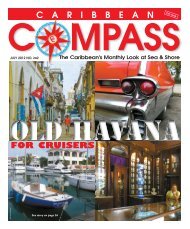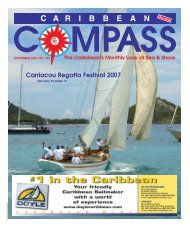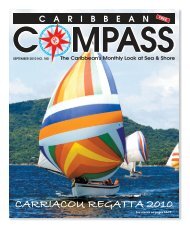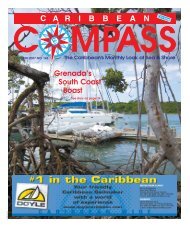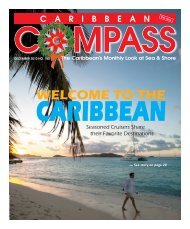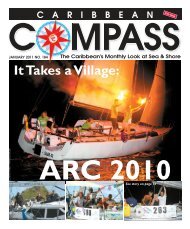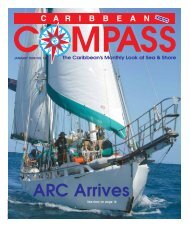Create successful ePaper yourself
Turn your PDF publications into a flip-book with our unique Google optimized e-Paper software.
A <strong>Caribbean</strong> Sailor’s<br />
Contribution to the<br />
US Whaling Industry<br />
by Norman Faria<br />
July 13th, 2010 is the 151st anniversary of the birth in Barbados of William T.<br />
Shorey. In 1886, he was the first African-American to captain a whaling vessel on<br />
the west coast of the United States, and one of the first nationwide.<br />
Perhaps more importantly, his inspirational working life in the whaling industry,<br />
which was so important at the time, underscored the contribution of immigrants to<br />
the United States. They helped build up that great country’s economy and all aspects<br />
of its social life and culture. Some, like Captain Shorey, were from the <strong>Caribbean</strong>,<br />
even at that early date.<br />
Captain Shorey died in 1919 in Oakland, California where he had retired with his<br />
American wife Julia Ann, who died in 1944. He is one of the featured individuals in<br />
a succinct but little-known work titled Black Hands, White Sails: The Story of African-<br />
American Whalers by Patricia McKissack and Frederick McKissack (published in<br />
1999 by Scholastic Inc., New York, and available at amazon.com).<br />
Whaling in the 1800s was a major part of the US fisheries sector. Whale oil was<br />
extensively used for lubricating machinery and for consumer items such as candles<br />
and soaps. By 1850, there were more than 500 US whale ships in both the Atlantic<br />
and Pacific Oceans. The ships stayed away from home port for as long as four years.<br />
Some of them visited the <strong>Caribbean</strong> in pursuit of the whales. Sometimes, as they put<br />
into port for food and rest, the captains signed on men from the islands as part of<br />
the crew. Most likely this is how Captain Shorey got to Boston, Massachusetts in<br />
1876 at the age of 17. The son of a Scottish-born planter and a black woman in<br />
Barbados, he probably signed on as a cabin boy.<br />
The focus of the book is on the relatively high number of black sailors and those<br />
from the <strong>Caribbean</strong> area, the Cape Verde islands and Native American communities,<br />
in the whaling industry. Some rose to be prominent businesspeople and shipbuilders.<br />
According to the McKissacks, by 1850 some 20 percent of the 3,000 whaling<br />
seafarers out of New Bedford, one of the main fishing harbours on the northeastern<br />
US seaboard, were Afro-American.<br />
There were two main reasons for this relatively high figure. One was that whaling<br />
was an opportunity for black (and some Amerindian) slaves to obtain some sort of<br />
freedom. The sailors were actually given a special identification paper that permitted<br />
them to move freely in ports where slavery was still practised. It must be remembered<br />
that commercial whaling really got underway in the 1700s, over a hundred<br />
years before. Slavery in the US was formally abolished in 1865 but a ship landed<br />
slaves from Africa in Alabama as late as 1859.<br />
CARIBBEAN MARITIME HISTORY<br />
Captain William T. Shorey and family<br />
US NATIONAL PARKS SERVICE<br />
Secondly, New Bedford (Nantucket was another main whaling port) and the surrounding<br />
townships were home to many Quakers. This “white” religious group was<br />
a significant advocate against slavery. The word had got around that they had long<br />
freed their slaves. The area was also a staging area, or stop, on the “Underground<br />
Railroad” escape route for slaves travelling toward Canada and freedom. Some<br />
Quakers were, however, themselves unscrupulous businesspeople.<br />
One black (his mother was an Amerindian) ship owner named Paul Cuffe (died<br />
1817) was a Quaker. Cuffe himself captained some of his ships and visited the west<br />
coast of Africa and the West Indies with cargo. His vessels were mostly black crewed.<br />
Again, it is likely that some <strong>Caribbean</strong> young men came to the US that way during<br />
that time.<br />
As an aside, there is evidence that a number of white whalers jumped ship in the<br />
islands. That is how the ongoing indigenous and allowable whaling activity in Bequia<br />
in the St. Vincent Grenadines was mainly started. There were also small whaling<br />
stations in Barbados, at and around the west coast town of Speightstown, during<br />
this period.<br />
Whaling life, or “going oiling” as the workers said, was rough. Cautioned the<br />
McKissacks: “Even though the Quakers might have been socially liberal, their influence<br />
stopped at land’s end… Once out at sea, men of colour were often at the mercy<br />
of bigoted captains, prejudiced mates, and racist crew members.” Generally though,<br />
from what I read of the industry in other sources, black and white and other coloured<br />
working-class sailors got on well together. Because of safety factors, they had to<br />
work as a team and in general they realized their interests were the same. All<br />
“greenies” (the term comes from being so seasick that their faces turned a sort of<br />
green colour), ordinary seamen, would get only 1/120th of the profit of the ship at<br />
the end of the voyage. The ship’s owners alone took 50 percent while the captain and<br />
officers received a sizeable portion. The McKissacks also write that the studies of<br />
ships’ logs and other records show that “lays” (the pay received at end of voyage) of<br />
blacks were lower than whites who had the same qualifications.<br />
In other ways, for both black and white, a sailor’s life at the time had its tribulations.<br />
Food was less than satisfactory. Fresh vegetables and “ground provisions”, as<br />
the <strong>Caribbean</strong> sailors would say, like potatoes, ran out after a few weeks. Living<br />
conditions in the cramped crews’ quarters up in the bows were filthy. They could<br />
never get rid of lice they brought from the rooming houses of unscrupulous landlords<br />
(some of them black). Stale smells like that of blubber oil and sweat abounded.<br />
Loneliness was a problem on long voyages, with the singing of sea chanties and<br />
making of scrimshaw something to while away the time. One’s life could easily be<br />
lost to an angry whale attacking the flimsy small whaleboat from which the mammals<br />
were killed with harpoons. Not surprisingly, only 20 percent of the black sailors<br />
returned for a second trip, though the figure was probably near that for white<br />
sailors as well.<br />
The New Bedford and neighbouring Boston areas had a high proportion of black<br />
Portuguese-speaking sailors who settled there and eventually intermarried with local<br />
(Amerindian and white) women. The men had been signed on in the Cape Verdes, a<br />
group of islands off Africa that were colonised by Portugal.<br />
By the time Captain William Shorey came ashore in 1908 with his family (his wife<br />
would often accompany him on his whaling trips before their two sons and daughters<br />
came along) the writing was on the wall for the industry. Oil (petroleum) was<br />
being commercially pumped in the mid-1800s; it would be a substitute for whale oil.<br />
It came just in time for the<br />
cetaceans, too. By then,<br />
they were virtually wiped<br />
out in most of the Atlantic.<br />
Today, owing significantly<br />
to the work of Greenpeace<br />
and other environmental<br />
groups, the great whales<br />
are largely protected,<br />
although that might<br />
change with a ruling at<br />
the International Whaling<br />
Commission meeting that<br />
is underway as this issue<br />
of <strong>Compass</strong> goes to press.<br />
The value of this Black<br />
Hands, White Sails is that<br />
it highlights the important<br />
inputs of immigrants<br />
in a little-known area of<br />
US society, and the role of<br />
ethnic minorities, particularly<br />
black people, in<br />
that contribution. We<br />
note, in contrast to the<br />
situation today, the relatively<br />
easy way the overseas-born<br />
could enter the<br />
US. Shorey himself was<br />
probably given a slip of<br />
paper by the ship’s captain<br />
and he obtained residency<br />
status that way. It<br />
is not known if Captain<br />
Shorey ever returned to<br />
Barbados on one of his 22<br />
voyages. There are several<br />
Shorey families still on<br />
the island and it would be<br />
interesting to see if any<br />
have connections to this<br />
remarkable man.<br />
Unlike others such as Frederick Douglass (who caulked whale ships’ seams as<br />
one of his jobs), and Cuffe, who were civil rights activists, Captain Shorey’s contribution<br />
was through his own unstinting dedication to disciplined, honest work and<br />
intelligent, fair and courageous leadership as a ship’s captain. Moreover, he is an<br />
inspiration for those who continue with the time-honoured traditions of travelling<br />
and making homes in other countries, working with people of other races.<br />
A former merchant seaman on the Geest Line, Norman Faria is a <strong>Compass</strong> correspondent<br />
in Barbados<br />
JULY 2010 CARIBBEAN COMPASS PAGE 29




